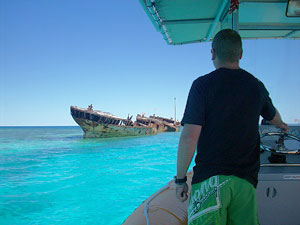

 | |||||||||||
|
|
Journals 2008/2009Zamaria Rocio
September 6, 2008 One of the favorite past times on the reef is snorkeling. Almost everyone can do this and it takes relatively inexpensive equipment. Well, I was told that today when the diving boat returned and after we had lunch that I would be going out to snorkel in the island's lagoon. This was wonderful news since I have been here I have not swam in this ocean so I was looking forward to this. We would be gone for only a couple of hours but that would be enough for me. Our coxswain would be Shawn who was also the project's manager. He was most helpful to me before I came to Australia. Shawn gave me many suggestions of what to bring here.
We had two other people from the laboratory plus a photographer and journalist on board with us. On our way out to the snorkeling sight we stopped to see two green turtles mating. These turtles have claws in their forelimbs and their bony shell is hard. Sorry, I did not take pictures of that. These Green Sea Turtles (Chelonia mydas) along with the Loggerhead Turtles (Caretta caretta) visit the island at different times of the year. Their nesting season is between the months of January and March. It is the female that comes ashore to lay her eggs and usually seven to thirteen weeks later they hatch. Depending of the temperature of the sand the baby turtles can be all females, males, or a combination of both. The green turtle hatchlings eat meat (carnivorous) whereas the adults are herbivores that eat algae. These turtles can swim thousands of miles between where they feed and nest. I am told that there are seven different types of turtles living around the world in the oceans and that six of them visit the seas and beaches of Australia. We went onward and stopped in an area scattered with clumps of live coral. Colorful fish like the angelfish, parrotfish, and anemone fish could be seen eating. In fact, these fish were constantly eating. They did not even give me much notice. They water was quite chilly (about 70 degrees F), so I had to wear a wetsuit. I swam around for about an hour, taking everything in. On the way back to the harbor, we saw a small group of humpback whales (Megaptera) passing the island. We stopped to watch them. In the winter, they travel northwards to the warmer coastal waters of Australia to breed. Then in summer they return to Antarctica where the krill is plentiful. These animals will produce underwater songs usually in their breeding grounds. These songs could last for thirty minutes or longer. Another distinguishing feature is their long pectoral fins.
|
||||||||||

